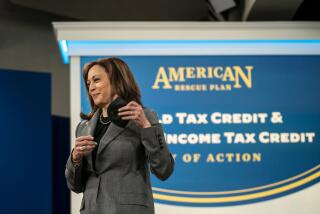Column: What George F. Will gets wrong about the progressive income tax

Speaking up for whom? Conservative columnist George Will addressing a Michigan audience in November.
The surest clue that a presidential election is nigh is that “flat tax” schemes have once again emerged as conservative shibboleths, the way crocuses herald the coming of spring.
Republican aspirants Ted Cruz, Ben Carson, and Rand Paul all have placed flat-tax proposals in their platforms. Their implicit -- and sometimes explicit -- argument is that there’s something inherently wrong with a progressive income tax, in which a higher proportion of income is levied from those with higher income than with lower income. A related theme is that this system redistributes income from rich to poor, which goes against the conservative grain.
The conservative columnist George F. Will codified these arguments into something of a manifesto last week. His Dec. 4 column went further than stating that the U.S. income tax is too progressive, which is the usual default argument: Instead, he wrote that the case for any progressive income tax is not merely weak, but “nonexistent.”
Whatever is the existing degree of progression, people who pay the top rate will think it is too much.
— Conservative economist Herbert Stein, writing in 1996
As is often the case with such absolutism, Will’s argument collapses under its own inconsistencies. Before we show how, a bit of history: The U.S. income tax as we know it is the product of the 16th Amendment, which was enacted in 1913. Progressivity was part of the resulting system from the inception. The first tax schedule imposed rates ranging from 1% (on incomes under $20,000, equivalent to about $480,000 today) to 7% (incomes over $500,000, or $12 million today).
Every U.S. tax schedule since then has had progressive rates, but the dream of a flat tax lives on. The last time it moved to the center of a presidential campaign was 1996, when it was promoted by GOP candidates Jack Kemp and Steve Forbes.
Yet as was pointed out then by Herbert Stein -- a former chief economist for President Nixon, writing in the Wall Street Journal -- their flat tax proposals were not truly flat. Most aren’t. The 1990s flavor typically exempted all income under a certain threshold; the Cruz, Paul and Carson versions all offer deductions, exemptions or rebates that would chiefly benefit the poorest.
Thus even the flattest proposals involve some -- yes! -- progressivity. As Stein observed, every flat tax has two bracket rates, zero for income below an exemption point, and some positive percentage for everything else. If the exemption were, say, $30,000 and all other income were taxed at 20%, then people with $30,000 would pay 0%, those earning $60,000 would pay 10% of their total income, those with $300,000 would pay 18%, and those declaring $3 million would pay 19.8%. That’s a progressive tax rate, and what’s left is a discussion about just how progressive the tax code should be.
Will himself implicitly acknowledges this as a fact. In his column he accepts society’s duty to “prevent extreme privation.” Any such program transferring wealth or income to the poorest of the poor is effectively indistinguishable from a tax break or rebate of some kind. Will’s case against progressive taxation falls down at the first hurdle.
One feature ostensibly shared by all “flat tax” proposals is their simplicity. You’ll hear about tax returns that can fit on an index card and about the consequent ease of abolishing the IRS. The flat tax, Will writes, “is what progressive taxation never is: simple.”
But the flat tax gang really doesn’t care about simplicity as such. Here’s a real simple tax plan, for instance: All income over $500,000 should be taxed at 100%. Would George F. Will or Ted Cruz consider this feature a virtue? Doubtful.
That brings us to the intellectual case for a progressive tax, which Will labels “nonexistent.” This is just his way of saying that he disagrees with the rationales made for it in the past. One is based on the declining marginal utility of a dollar: The argument is that because each additional dollar means less to a person with $1 million in hand than to someone on minimum wage, a higher proportional tax bite from the former imposes less sacrifice than the same proportion taken from the former.
Will is correct in observing that this implies making moral judgments about how people spend their money, which he rules out of order. Yet society is fundamentally about imposing moral strictures on certain behaviors and encouraging others. (Some of the candidates offering flat tax plans talk even more about the nation’s Judeo-Christian precepts.) The tax code has been an instrument for expressing these judgments for more than a century, taxing “sinful” products such as tobacco and alcohol and relieving such expenditures as charitable donations of any tax at all.
Nor are utility judgments as arbitrary as Will implies: Is it really that hard to distinguish between a family that must spend all its spare income on staple foods and one that can fill the larder and still have money left over for a vacation home, or several?
This wasn’t a problem for Adam Smith. In “The Wealth of Nations,” the father of laissez-faire economics observed that “the necessaries of life occasion the great expense of the poor” while “the luxuries and vanities of life occasion the principal expense of the rich.” Therefore, he concluded, “it is not very unreasonable that the rich should contribute to the public expense, not only in proportion to their revenue, but something more than in that proportion.”
The most persistent argument in favor of a progressive tax is that it suppresses income inequality. Stein in 1996 cited the words of the Chicago laissez-faire economist Henry Simons, who had been his teacher, to the effect that extreme inequality was “unlovely” and the progressive tax was a way to reduce it. Stein could have gone further, for what Simons actually wrote in 1938 was that the wealth and income distribution of his era had reached “a degree ... of inequality which is distinctly evil or unlovely.”
Simons accepted some inequality as “unavoidable or essential for motivation,” but said it should be “tolerated only so far as the dictates of expediency are clear.” It’s possible, even likely, that he would find the expanding inequality of today’s U.S. economy every bit as noxious as that of the 1930s.
The motivation of pundits like Will to defend inequality and deplore a tax code that aims to reduce it, however inadequately, typically is shrouded in rhetoric about “economic growth” and “freedom from tyranny.” Will quotes a 1952 essay by two of Simons’ successors at Chicago, Walter J. Blum and Harry Kalven Jr., stating that the progressive tax code is the project of a system in which “the majority can vote distinctive burdens for the minority.”
Does that bear any relation to today’s economic reality? The defining feature of the American system is that a minority of voters is using their wealth to extract economic rents from the majority. As the labor share of national income has been falling, the top 1% extract an outsized proportion of gains from economic growth, augmented by an income tax system that has become materially less progressive over the last half century, as Thomas Piketty and Emmanuel Saez have shown.
Will, like others who reflect the claims of the 1%, argues that “burdens imposed on the wealthy minority [such as progressive taxation] can injure the majority by impairing economic incentives, thereby suppressing growth.” Where’s the proof of that? Certainly not in economic statistics, which have consistently failed to show a pattern linking higher progressivity in the tax code to lower economic growth.
It may be more likely that the distaste harbored by Will and the flat-taxers for higher marginal tax rates imposed on the wealthy reflect a rule posited by Stein in his 1996 Wall Street Journal essay, which he derived from “60 years of observation.” It was this: “Whatever is the existing degree of progression, people who pay the top rate will think it is too much.”
Keep up to date with Michael Hiltzik. Follow @hiltzikm on Twitter, see our Facebook page, or email michael.hiltzik@latimes.com.
More to Read
Inside the business of entertainment
The Wide Shot brings you news, analysis and insights on everything from streaming wars to production — and what it all means for the future.
You may occasionally receive promotional content from the Los Angeles Times.











